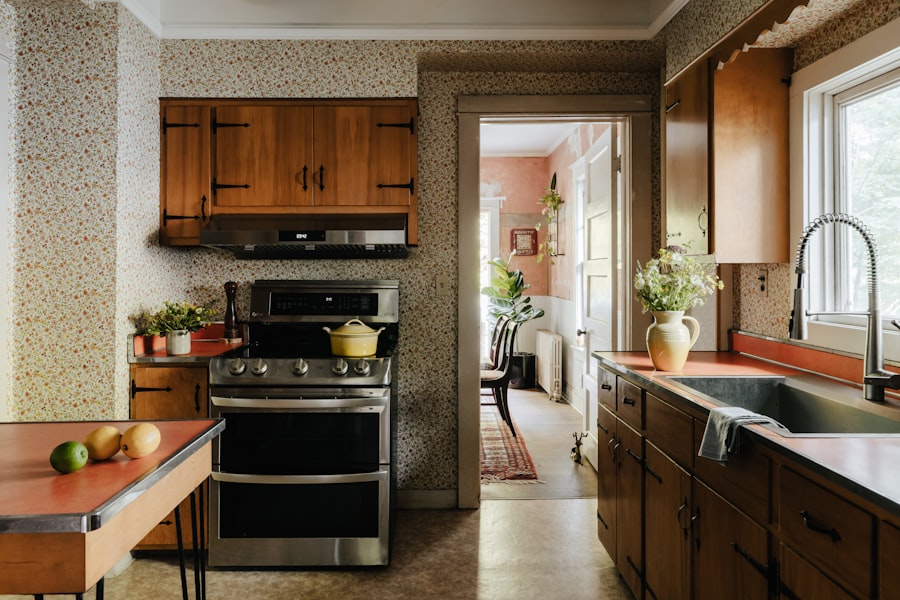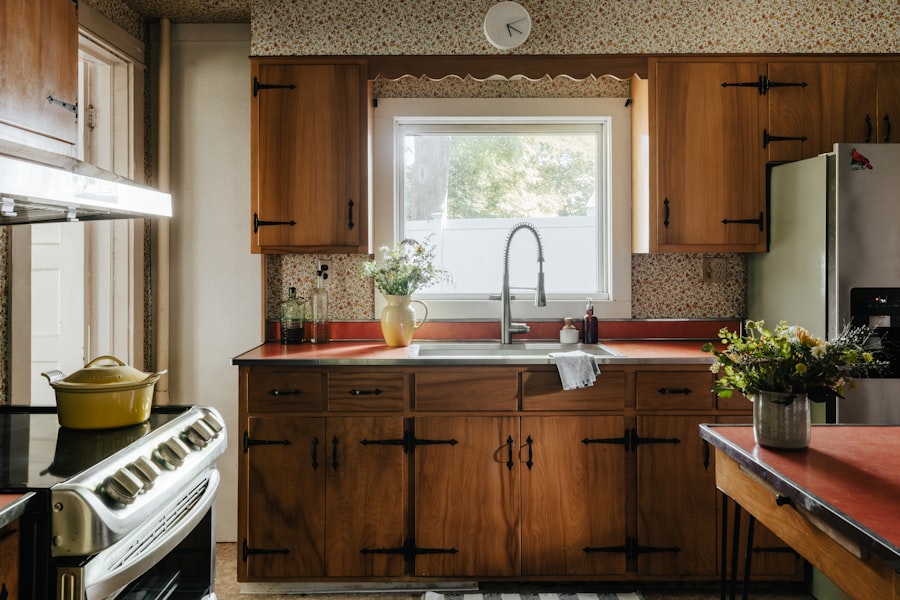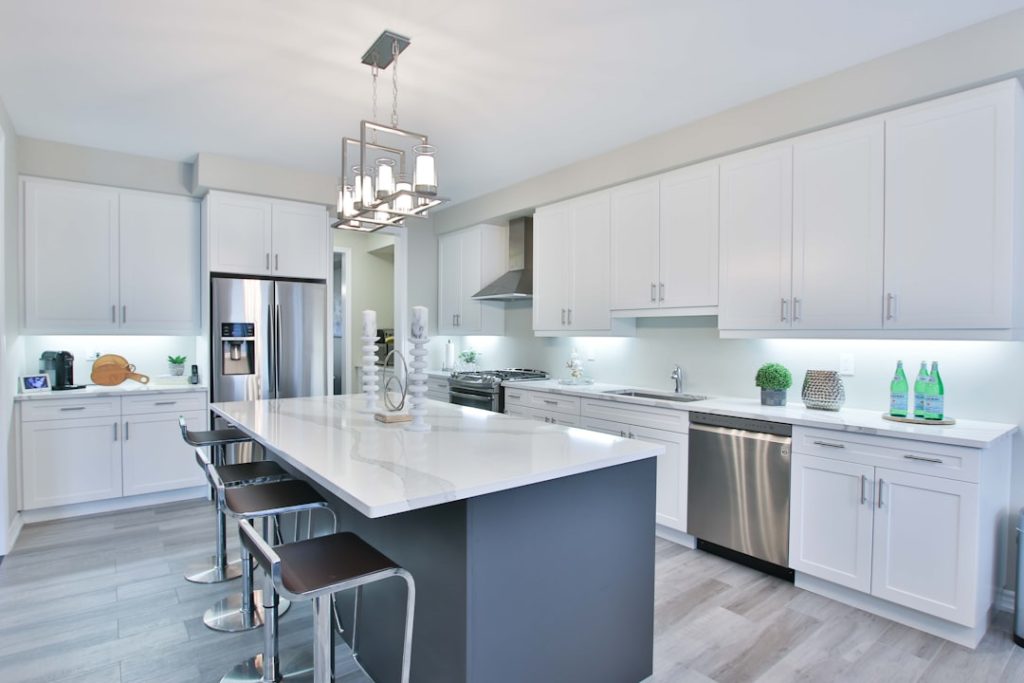Custom kitchen cabinets play a pivotal role in the overall functionality and aesthetic appeal of a kitchen. Unlike stock cabinets, which are mass-produced and often limited in design and size, custom cabinets are tailored to meet the specific needs and preferences of the homeowner. This personalization allows for a more efficient use of space, particularly in kitchens with unique layouts or dimensions.
For instance, a custom cabinet maker can design cabinets that fit perfectly into awkward corners or under sloped ceilings, maximizing storage and usability. This level of customization not only enhances the kitchen’s functionality but also contributes to a cohesive design that reflects the homeowner’s style. Moreover, custom kitchen cabinets can significantly increase the value of a home.
Potential buyers often view a well-designed kitchen as a major selling point, and high-quality custom cabinetry can set a home apart in a competitive real estate market. The craftsmanship involved in creating custom cabinets typically results in superior durability and longevity compared to their pre-fabricated counterparts. Homeowners can choose materials and finishes that align with their vision, ensuring that the cabinets not only serve practical purposes but also enhance the overall aesthetic of the kitchen.
This investment in quality and design can yield substantial returns when it comes time to sell the property.
Key Takeaways
- Custom kitchen cabinets enhance functionality and style tailored to your needs.
- Research and visit local cabinet makers to compare quality and pricing.
- Explore various customization options, including materials and finishes.
- Ensure professional installation for durability and proper fit.
- Plan your budget carefully to enjoy the long-term benefits of custom cabinets.
Researching Local Custom Cabinet Makers
When embarking on the journey to install custom kitchen cabinets, thorough research is essential to find reputable local cabinet makers. Start by seeking recommendations from friends, family, or neighbors who have recently undertaken similar projects. Personal referrals can provide valuable insights into the quality of work and customer service offered by various cabinet makers.
Additionally, online platforms such as Yelp, Google Reviews, and Houzz can offer a wealth of information through customer testimonials and ratings. These resources can help narrow down potential candidates based on their reputation and portfolio. Once a list of potential cabinet makers has been compiled, it is crucial to delve deeper into their backgrounds.
Investigate their experience in the industry, focusing on how long they have been in business and whether they specialize in custom cabinetry. A well-established cabinet maker is likely to have honed their skills over time and developed a keen understanding of design trends and construction techniques. Furthermore, reviewing their portfolio can provide insight into their design style and craftsmanship.
Look for examples of completed projects that resonate with your vision for your kitchen, as this will help ensure that the cabinet maker can bring your ideas to life.
Visiting Showrooms and Getting Quotes

Visiting showrooms is an integral step in the process of selecting custom kitchen cabinets. Showrooms provide an opportunity to see materials, finishes, and designs in person, allowing homeowners to visualize how different elements will come together in their own kitchens. During these visits, take note of the quality of craftsmanship displayed in the cabinets on display.
Pay attention to details such as joinery, hardware, and overall construction quality, as these factors can significantly impact the durability and functionality of the cabinets. While exploring showrooms, it is also essential to gather quotes from multiple cabinet makers. This process involves discussing your specific needs and preferences with each cabinet maker and obtaining detailed estimates for your project.
Be sure to ask about what is included in the quote—such as design services, materials, installation, and any additional fees—to ensure you are making an apples-to-apples comparison. Keep in mind that the lowest quote may not always represent the best value; consider factors such as quality of materials, craftsmanship, and customer service when evaluating your options.
Exploring Customization Options
| Customization Option | Description | Impact on User Experience | Implementation Complexity | Example Use Case |
|---|---|---|---|---|
| Theme Selection | Allows users to choose color schemes and visual styles | Enhances personalization and accessibility | Low | Dark mode toggle in apps |
| Layout Configuration | Users can rearrange or resize interface elements | Improves usability and workflow efficiency | Medium | Dashboard widget arrangement |
| Feature Toggles | Enable or disable specific features or modules | Allows tailored functionality based on user needs | Medium | Turning on/off notifications |
| Language Preferences | Selection of preferred language for interface | Increases accessibility for diverse users | Low | Multi-language support in websites |
| Custom Shortcuts | Users define keyboard or gesture shortcuts | Speeds up frequent actions and improves efficiency | High | Custom hotkeys in software |
One of the most appealing aspects of custom kitchen cabinets is the vast array of customization options available to homeowners. From cabinet styles to hardware choices, every detail can be tailored to suit individual preferences. Homeowners can choose from various cabinet styles, including traditional, modern, rustic, or transitional designs.
Each style offers unique characteristics that can dramatically alter the look and feel of a kitchen. For example, shaker-style cabinets are known for their clean lines and simplicity, making them a popular choice for contemporary kitchens. In addition to style, customization extends to functional features as well.
Homeowners can incorporate specialized storage solutions such as pull-out shelves, lazy Susans, or built-in spice racks that enhance organization and accessibility. The ability to customize cabinet sizes also allows homeowners to create a layout that maximizes space efficiency. For instance, if a homeowner has a narrow kitchen, they might opt for taller cabinets that reach up to the ceiling, providing additional storage without sacrificing floor space.
This level of personalization ensures that every inch of the kitchen is utilized effectively while reflecting the homeowner’s unique taste.
Considering Materials and Finishes
The choice of materials and finishes is critical when designing custom kitchen cabinets, as these elements significantly influence both aesthetics and durability. Common materials used in cabinetry include solid wood, plywood, MDF (medium-density fiberboard), and particleboard. Solid wood is often favored for its natural beauty and strength; however, it can be more expensive than other options.
Plywood offers a good balance between cost and durability, making it a popular choice for many homeowners seeking quality without breaking the bank. Finishes also play a vital role in determining the final look of custom cabinets. Homeowners can choose from various stains, paints, or glazes to achieve their desired appearance.
For instance, a rich walnut stain can impart warmth and sophistication to traditional cabinetry, while a sleek white paint finish may lend a modern touch to contemporary designs. Additionally, finishes can affect maintenance requirements; for example, painted surfaces may require more upkeep than stained wood due to potential chipping or wear over time. Understanding these nuances will help homeowners make informed decisions that align with their lifestyle and aesthetic preferences.
Ensuring Proper Installation

The installation process is a critical phase in the journey toward achieving beautiful custom kitchen cabinets. Even the highest quality cabinets can fall short if not installed correctly; therefore, it is essential to hire experienced professionals for this task. A skilled installer will ensure that cabinets are level, securely anchored to walls, and properly aligned with one another.
This attention to detail not only enhances the visual appeal of the kitchen but also ensures that doors open smoothly and drawers function properly. Before installation begins, it is advisable for homeowners to communicate clearly with their cabinet maker or installer about any specific requirements or concerns they may have. This includes discussing any potential obstacles such as plumbing or electrical fixtures that may affect cabinet placement.
Additionally, homeowners should be present during installation to address any questions or adjustments that may arise on-site. By actively participating in this process, homeowners can help ensure that their vision is realized accurately.
Budgeting for Custom Kitchen Cabinets
Budgeting for custom kitchen cabinets requires careful planning and consideration of various factors that contribute to overall costs. The price of custom cabinetry can vary widely based on materials used, complexity of design, size of the kitchen, and labor costs associated with installation. Homeowners should begin by establishing a realistic budget that reflects their financial situation while allowing for some flexibility to accommodate unexpected expenses.
It is also important to consider long-term value when budgeting for custom cabinets. While initial costs may be higher than stock options, investing in quality cabinetry can lead to greater satisfaction over time due to enhanced functionality and aesthetics. Additionally, high-quality custom cabinets are likely to last longer than cheaper alternatives, reducing the need for future replacements or repairs.
Homeowners should weigh these factors carefully when determining how much they are willing to invest in their kitchen renovation.
Enjoying the Benefits of Custom Kitchen Cabinets
The benefits of custom kitchen cabinets extend far beyond mere aesthetics; they significantly enhance both functionality and enjoyment within the space. With tailored storage solutions designed specifically for individual needs, homeowners can experience greater organization and efficiency while cooking or entertaining guests. For example, having designated spaces for pots and pans or built-in wine racks can streamline meal preparation and create an inviting atmosphere for gatherings.
Furthermore, custom cabinets allow homeowners to express their personal style and create a unique culinary environment that reflects their tastes and lifestyle choices. Whether opting for sleek modern lines or intricate traditional details, custom cabinetry transforms kitchens into personalized sanctuaries where families gather and memories are made. The satisfaction derived from having a beautifully designed space that meets practical needs cannot be overstated; it fosters a sense of pride in homeownership while enhancing daily living experiences.
In conclusion, investing in custom kitchen cabinets is not merely about aesthetics; it encompasses functionality, personalization, and long-term value that enriches both daily life and home equity. By understanding the importance of customization options available through local cabinet makers while considering materials and installation processes carefully, homeowners can create kitchens that truly reflect their unique vision while enjoying all the benefits that come with high-quality cabinetry.



